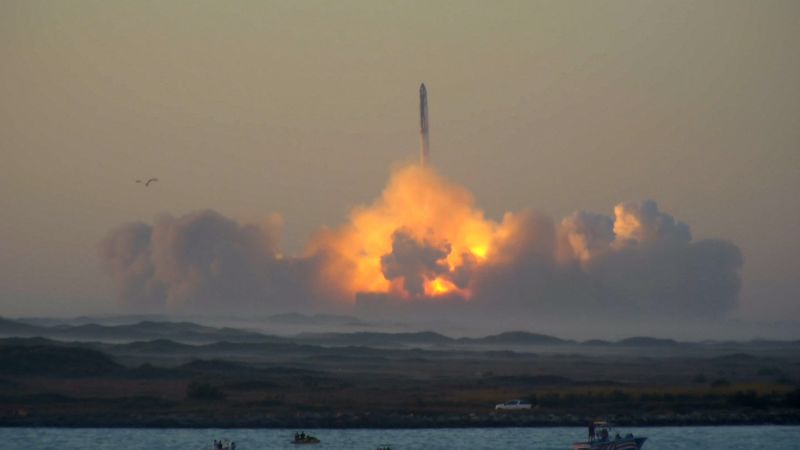SpaceX’s Starship rocket system reached several milestones in its second test flight before the rocket booster and spacecraft exploded over the Gulf of Mexico.
Sounds like a proper test. But annoying that Musk’s name has to be plastered over every headline related to Xitter, Tesla Motors, Starlink and SpaceX.
It’s interesting. When a spacex launch goes well, you don’t see his name attached in the headline. But on this explosion, his name comes first.
I mean, It’s all business. Disaster and Elon musk are going hand in hand since his turn into a pretty decent, hateable villain a couple years ago. So putting his name on an explosion gets the “Awfuckyeah give me musk hate porn” crowd. Even though he had almost as little to do with this failure as he did with the Hindenburg. But this gets clicks.
It’s pretty annoying, because we can see right through it and their motives are shitty. Don’t get me wrong, Elon musk is a douchebag, but CNN’s motives for attaching his name to this article directly in the headline aren’t a mystery. And they’re selfish. So we can hate both CNN and musk at the same time. Convenient.
CNN writer here puts Musk in the first line of the article where it was considered a success.
https://edition.cnn.com/2020/12/09/tech/spacex-starship-40000-foot-test-flight-scn/index.html
In this article Musk’s name isn’t there… which is the kind of article I would rather see:
https://www.cnn.com/2023/11/18/world/starship-launch-science-newsletter-wt-scn/index.html
Hate the game, not the player.
But one is from 2020, before he turned into a villain. So that’s still tracks. And the second one is from this year. And they’re talking about a feat. I still think my theory is right.
Plus, it’s CNN. I…didn’t think people were really able to defend CNN as anything more than a moneymaking venture. Just because trump hated them, it’s like we all forgot everything they’ve ever done.
Interestingly, they actually took Musk’s name out of this headline (after I posted it, ugh), but managed to replace it with a very BuzzFeed-y one.
Yeah it’s kind of annoying…
Guess CNN is keeping a close eye on what us on Lemmy think of their work. We’re tastemakers.
So the booster worked in that it achieved lift off and properly separated. Did the other stages complete their jobs? Because this looking like it’s only a failure in the sense that the booster didn’t do the cool we-live-in-the-future part of flipping itself over and landing.
The main focus of this test was stage separation. In that sense it was a roaring success. Also, looks like they managed not to trash the landing pad this time. So that will make it easier to get the next flight approved. But clearly there’s still a long way to go.
Also demonstrated the flight termination systems, for both stages, it seems.
It appears they got their engine development under control too. Every one lit and burned effectively full duration, on both stages.
So basically they’ve fixed every issue displayed in the first flight I’d say.
Still some work to do in the not-blow-up department, though.
I mean, the entire purpose of the “blow up the ship” system is to blow it up, so that part worked correctly
Nope. Blew up uncontrolled.
Yes, but they blew up correctly. What they are saying is it is all new issues and the old ones are fixed. This is good for test vehicles.
Just for anyone wondering what blew up correctly means. The flight termination system didn’t work properly on the 1st launch. Starship and the booster didn’t separate and it tumbled in the air for too long. That puts people at risk as it might go out of the safe area.
This time, when whatever went wrong went wrong, the system triggered properly and both vehicles blew up.
They pick and chose what was the “focus” every time there’s a launch. In reality focus is for everything to work. It didn’t work this time either. It was worse the first time, but this time at the moment it looks better. Things worked out but second stage blew up in LEO which can cause all kinds of issues with debris and other satellites.
They’ve been pretty transparent about their expectations for these early test flights, and today’s achievements match those expectations. For example, they didn’t bother securing all the thermal tiles because they didn’t really expect to survive re-entry.
The rocket didn’t go to LEO. This was intentional, because they knew that this flight was unlikely to survive and they’re as concerned about space debris as you are. All the debris either burned up or fell into the ocean.
Look up what LEO region is. It’s everything beneath 2000km. But the point still stands, it was big ship with big explosion. You can’t be sure things didn’t get thrown outwards. Also, SpaceX is not exactly known for respecting the environment. In fact they’ve been constantly criticized about that.
But isn’t the key aspect here “orbit”? I get that the FTS would lengthen the trajectory of some of the debris, but would it be enough to create a stable orbit? The original trajectory was going to splashdown near Hawaii.
I certainly agree that there are lots of environmental downsides to space exploration that are increasingly overlooked, I’m just not sure that there’s anything extra egregious about this flight.
Well, I don’t know if there is anything egregious about this either. Last time there was a spaceship test it was touted as a great success while tons of concrete flew in all directions destroying everything in their path from cameras to people’s cars. Most importantly launch site is in the middle of the nature’s reserve and agency in charge of that already filed a number of complaints because of their reckless destruction. “Genius” in charge said it was planed and only concrete was just fine, until it wasn’t.
So I never trust what their PR says. Last time it was also planned and great success but they managed to get their launch license suspended. Am just not quick to jump to conclusions about whether this made any damage or not. Hopefully none of the debris managed to destroy anything.
Yeah, the concrete storm wasn’t great last time. They did have some engineering reasons to believe it would work for a single launch, but it seems like there was more subsurface damage to the concrete than they realized. As far as I know the only property that was significantly damaged was related to the company, but I’m sure there were some smaller residential insurance claims for the dust.
Part of the reason Saturday’s launch was delayed was so that more environmental assessments could be performed. A few weeks ago there some government scientists taking samples at the launch site for a baseline measurement to compare against in the future, and the entire project was reviewed by environmental regulators. So, those agencies were very involved in approving the launch license and SpaceX can’t just do whatever the owner wants them to. I guess my point is that it’s not strictly PR-speak, there really are qualified people making these decisions. But I agree that it’s not great to have the facility in the middle of a sensitive wetland, and no doubt there was backdoor politicking. I wish SpaceX would do more to offset the harm they cause, but I still think the StarShip project does more good than harm.
I know you’re just trying to be negative, I assume because of Musk (I hate him too). You’re not being accurate, on purpose or otherwise it doesn’t matter. It didn’t even reach orbit. How did it blow up in Low Earth Orbit?
Am not trying just to be negative. Explosion disperses debris in all directions, and it wasn’t a small explosion and it wasn’t a small spaceship either but more to the point to quote wikipedia:
The term LEO region is also used for the area of space below an altitude of 2,000 km (1,200 mi) (about one-third of Earth’s radius).[3] Objects in orbits that pass through this zone, even if they have an apogee further out or are sub-orbital, are carefully tracked since they present a collision risk to the many LEO satellites.
So I should have said LEO region, but still. Rocket exploded at 146km, which can pose issues. Hopefully it won’t. But it remains to be seen. Kessler syndrome is a real threat.
It’s about velocity, not altitude. The pieces from the explosion would need to get a fairly dramatic dv addition prograde to end up near orbital. The explosion seems pretty undirected, so the force will be spread in all directions, so most of the force won’t be prograde. Even still, it can’t be orbital. It’d need some other force added later on its trajectory or it eventually had to pass through the same altitude that the explosion happened, which is in-atmosphere and will cause fairly quick decay. There is no risk of Kessler syndrome. It could potentially have posed a risk to some very low satellites, but we’d already have seen that happen by now if it were going to.
Let’s hope that’s the case. It’s unlikely I agree.
It seems that Starship, the second stage, experienced RUD from the automated FTS at around the time it was expected to shut off its engines.
Edit: RUD is Rapid Unscheduled Disassembly. Basically an explosion. FTS is Flight Termination System, which explodes a rocket if something goes wrong in a potentially dangerous way.
Which is an incremental improvement over the prior attempt. People mock these failures as though they have never built anything and have no concept that any step forward is a win when you are trying to do something that has never been done before. They got the smaller rockets working. It will just take time to get this giant one working.
Yeah but to get from here to a 99.99% reliability is a very very long way
Look at the Falcon rocket history. They started out at a very similar point, though at a smaller scale. And yet now they are comfortably human rated. They have landed the last 171 times in a row without fail, with another one coming this evening to add to that incredible number.
The guy at the helm is a terrible person, but this does not discredit the absolutely insane progress they have made.
What do you mean, never been done before?
We had satellites in space 70 years ago.
Delta clipper was pioneering reusable boosters in the 90’s.
SpaceX themselves have been recovering boosters for almost ten years now. They learned nothing from that?
I’m not saying it should work every time out of the gate, but they haven’t even reached orbit yet. And musk himself has said that starship being operational is critical to SpaceX and starlink if they don’t want the companies in serious financial trouble. So, it’s not like they’re taking their sweet time with these as incremental tests.
Fully reusable super-heavy rockets with multiple full stage combustion engines running on Methane have been done before? You mind sharing sources because I can’t find any.
Closest thing I can think of is the Soviet N1 rocket (about 2/3 the thrust of Starship) which the Soviets really struggled with and ended up abandoning, and it wasn’t even close to being reusable.
Didn’t the N1 have a massive launch pad failure that we still don’t know how many people it killed?
Can’t find any reference to anyone dying or getting injured, but in terms of pad damage it definitely takes the cake.
The first Starship may have put a hole in the pad, but the N1 obliterated it.
You’re comparing the world’s first fully reusable rocket that also happens to be the world’s most powerful operational rocket to old technology? The payload capacity of this vehicle is immense. There is not a single aspect of it that isn’t brand new, from its proportions, engine power cycle, engine amount, construction materials, you can go on almost endlessly.
These incremental tests are what allow them to move at this incredible speed. Traditional rocket development doesn’t take years, it takes decades. You have to consider that this isn’t a government trying to outcompete another one, it’s a private company. They are pushing the envelope with everything they’re doing.
Nah, I mock this and I’ve built shit. The fact that musk is failing at stuff we’ve done before is hilarious.
Uh… Who has done this before?
We’ve been to the moon already.
What? 😂 This flight wasn’t supposed to go to the moon. It’s a test flight. They’re developing the most powerful rocket to have ever flown and recover every part of it. They’re also using a power cycle for the engine that has never been used before. So no, what SpaceX is doing has never been done before.
Musk is a twat but the people working at Spacex have shown themselves to be quite competent at what they do.
With an eight times higher injury rate? That’s not competence.
What aspect of this “has never been done before”? Its a multi-stage rocket (NASA and the Soviets have been doing that for about seventy-ish years and the Nazi scientists we all recruited were doing it for even longer). The main innovations are material choice (which is debatable) and landing a rocket on a pad, which is mostly a function of having good computers.
Space flight is hard. That said, there is a very strong argument for being much less iterative. Especially when the quest for a reusable rocket involves constant spraying of wreckage across oceans and land.
In the respect that they’re trying to get the world’s largest rocket to separate and land itself. You know, be reusable.
Mentioned this in the other branch but:
The Space Shuttle was already a “reusable rocket”. And the Saturn Vs would be recovered and refurbished, where possible. The main issue is that, much like with the space shuttle (and the “Starship” rockets): A LOT of wear and tear occurs during takeoff and re-entry. Reuse involves a LOT of repair and maintenance that often gets short cutted to save money. Which… is what leads to tragedies like Challenger and Columbia.
And I addressed the landing rockets on a pad. It is primarily a function of having MUCH better computers these days. And I was going to talk about how that has already been done but, while checking if Blue Origin also do it, I came up on this
So… it wasn’t even “never been done before” a decade ago.
The big reason why we moved away from the Space Shuttle was… well, mostly Challenger and Columbia. It got that “This is bad technology” juju. But also, the costs of reuse are significant and drastically increase the cost per payload. I’ve read some good articles that argue we could make a MUCH cheaper and MUCH better space plane with modern tech but I am not qualified to assess that.
But… that also applies here. Having a rocket that lands itself is great and significantly reduces damage from recovery (whether it is thumping wrong in the ocean or getting damaged in transit). But that means you need a lot more fuel and a lot more weight for all the advanced maneuvering systems. And as you actually get out of the atmosphere, you now are increasing those costs considerably.
Whereas the old capsule system, while not sexy in the slightest, “works”. Get the payload into space and then, when ready, use a minimal amount of fuel to de-orbit in a controlled manner and deploy a parachute once you aren’t on fire anymore. But the main drawback to that is that the pod itself is incredibly limited in size and scope. With most modern missions expected to dock at a space station this matters a lot less. But I expect a return of a “space plane” design if we ever actually do a crewed mission to Mars.
The shuttle was hardly reusable. Yea, the airframe was, but after the first launches NASA discovered how fragile it really was.
Had they taken SpaxeX’s approach, they would’ve discovered those issues much sooner and been able to correct them instead of mitigate them.
What we’re seeing play out is an Agile project vs Waterfall project.
Agile, as the name implies, enables small, early course corrections so you don’t waste effort and get stuck with something you weren’t intending.
We’re also seeing the difference between private sector risk management vs government. (Risk isn’t just “exploding rocket”, but risk to the investment of time, resources, opportunity, etc).
The space shuttle was a bus on boosters we had to fish out of the ocean. It was expensive and had a very limited cargo capacity.
Okay?
I mean, I very much forget what the “marketing” was. But like I mentioned above, the real value is the crew and scope of missions. You have a lot more space to move around and do Science! and whatever else.
The dragon capsule and falcon nine is a bus on boosters. It can only deliver people OR cargo. Not both.
The space shuttle could deliver crew, cargo, and mission modules in one launch. It was a very versatile and 75% reusable too. Compared to falcon which is only about 50% reusable.
and landing a rocket on a pad, which is mostly a function of having good computers.
Launching a rocket is even easier, it’s mostly a function of having a big tank of propellant and powerful engines. A big rocket ? Just need a bigger tank and bigger engines.
RUD, aka “Rapid Unscheduled Disassembly”. I love how you can make “shit blew up in a way we didn’t expect” sound so mundane.
Well done to Musk and team for what most people would deem a huge success. Great to see. Really fun to watch and follow space x huge successes over the years.
Sorry it goes against the narrative and people can’t enjoy how great this is.
I’m frankly impressed they got 30 methane burning rocket engines to run flawlessly like that. mind boggling how quickly it leapt off the stand. fuck musk 8 ways from sunday, but I dig spaceX, shotwell has figured out how to manage musk’s bullshit apparently and is doing great work.
The 33 engines burning all together was really impressive to watch. The burn looked so clean and compared to the previous launch where engines where just failing on after another is was nice to see the huge progress.
I have to be able to separate the Space Baby’s idiotic antics from SpaceX. I’m simply to excited about what SpaceX is doing. My whole bloody life I’ve dreamed that we would return to space in a real fashion. This is the first time I have a glimmer of hope.

It is quite the accomplishment to get to the Karman Line though so credit to SpaceX’s engineers.
On the one hand I want to enjoy Musk failing, but at the same time I want to praise the people who are putting all their time and effort into the project, so this comment speaks to me.
Really? Because I’m actually pretty pissed off that a shit load of American tax dollars went to this fuck face’s shitty corporation instead of NASA just so he could do everything as cheaply and shittily as possible and it could blow up like the dumpster fire it is as a result. May as well have had that Nazi fuck burn the money on a live Twitter feed while he laughed in our face and flipped us all off.
You do realize that most of the money NASA has given SpaceX has been in the form of contracts to launch missions for them? I’m pretty sure very minimal tax dollars are going to Starship development right now, especially compared to other launch providers (ULA, Blue Origin, ect.) It’s because of SpaceX that America is able to launch Astronauts to space without using Russia since the Space Shuttle was retired.
Take a break dude
Yeah, I was venting. I took like a two day break lol. That guy really pisses me off.
One of the risky things is that second stage blew up in LEO, potentially causing a lot of issues with debris. We are yet to see the real consequences.
It blew up about 3000 km/hr short of orbit, so thankfully all of it has burned up in Earth’s atmosphere already :)
Also to make it clear, it was never planned to even make it to LEO. SpaceX has made it very clear that they wanted to get close to the energy experienced during an actual reentry without actually making it to orbit.
Here’s a pre-launch article in case anyone wants to compare pre-launch expectations to reality.
Four out of five ain’t bad
While this test was much more successful than the last one, it shows it will be at least a couple years before starship is fully operational at this rate if development and who knows when they’ll be able to get it crew rated.
So I’m already willing to bet artemis 3 gets delayed by at least a year while starship gets developed, which is a big shame.
But at least they’ll get there eventually. NASA so far has been entirely incapable of creating their own lander or even contract anyone who could.
What are you on about? Literally the only people to ever make a lunar lander were NASA??
No that one was designed by Grumman. NASA contracted with them for the design, like they’re looking to do with the new lander with SpaceX. Blue Origin and Dynetics were also options, but their proposals had huge flaws and were deemed much more risky than SpaceX, which is saying something.
NASA so far has been entirely incapable of creating their own lander or even contract anyone who could.
The first part of your statement is screwy: NASA doesn’t build stuff themselves, they set mission requirements. Their normal approach is to pay a contractor to design and build something to satisfy those requirements. In the case of SpaceX, the company designs and builds with (more of) its own money and then sells rides to NASA.
The second part is screwier: the only US lunar Landers have been traditional NASA programs. What are you basing your assertion that NASA can’t procure one on?
Stop sniffing farts. NASA has landed on so many planets Musk probably can’t count that high up. Also, don’t forget NASA funds SpaceX playthings. Musk positions himself so high and talks about canceling subsidies, but in reality without them there would be no SpaceX.
There’s only 8 (or 9 depending on who you ask) planets in the solar system. So Musk would have 2 fingers to spare. And we haven’t even “landed” on all of them (not sure how you’d land on a gas giant…)
Wait for a while then make a claim it was a success. Such a huge ship exploding in low earth orbit which is dense with satellites. We are yet to see what kind of damage that did.
It blew up about 3000 km/hr short of orbit, so thankfully all of it has burned up in Earth’s atmosphere already :)
I don’t believe that’s true, some of the debris more than likely made it back to the ground over the ocean. There are weather radars that picked up the debris and they don’t scan super high up into the atmosphere.
You’re right, that’s my bad. I just meant to say the debris hasn’t gone into orbit.
Gotta love that “Starship breaks the sound barrier during launch” image with the shockwaves visible. NO that is not what happens because the sound barrier was broken, the rocket was already going trans- or supersonic and the resultant shockwaves became visible briefly due to atmospheric conditions. Shockwaves do not spontaneously become visible at the point of transition.
Nonetheless we’re going to see that image pasted over and over on social media stating that it’s the transitional indication of breaking the sound barrier.
This is the best summary I could come up with:
SpaceX’s gargantuan deep-space rocket system, Starship, safely lifted off Saturday morning, but ended prematurely with an explosion and a loss of signal.
About two and a half minutes after roaring to life and vaulting off the launchpad, the Super Heavy booster expended most of its fuel, and the Starship spacecraft fired its own engines and broke away.
“The automated flight termination system on second stage appears to have triggered very late in the burn as we were headed down rage out over the Gulf of Mexico,” aerospace engineer John Insprucker said.
NASA is investing up to $4 billion in the rocket system with the goal of using the Starship capsule to ferry astronauts to the lunar surface for its Artemis III mission, currently slated to take off as soon as 2025.
The endeavor is aiming to return humans to the moon for the first time in five decades, and the successful completion of this test flight would bring the US space agency and SpaceX one step closer to that goal.
During that test flight, several of the Super Heavy’s engines unexpectedly powered off and the rocket began spiraling out of control just minutes after liftoff.
The original article contains 540 words, the summary contains 195 words. Saved 64%. I’m a bot and I’m open source!
Love how it’s called “deep space rocket system” and yet, this was the only time it managed to reach low earth orbit.
They blowed up good
Blowed up real good
Now if only Elon were on Farm Film Report.
Does this outcome just litter the Gulf with debris and pollutants or what?
That’s pretty much all rocket launches that aren’t Falcon 9 right now, all over the oceans.
I think the Gulf has plenty of steel in it already, and the liquid methane and oxygen probably isn’t getting there, not that they’d be an issue really. It’s a non-issue compared to shipping, for example.
Interesting, thanks.
Wouldn’t be surprised if it struck London.
The moon belongs to China now.
Booster: deleted
Spaceship: deleted
Earth: polluted
Resources: deleted
“Manned Mars mission in 2024 if we’re lucky”: not even a hint of it.
“Manned Mars mission in 2026”: lolYou can pretend the “test” is a huge success, just like I pretend that my programs crash because they’re still in “beta”.
Full self driving next year™
Did they annihilate the launchpad again?
They made a bunch of really cool changes to address the issues from last time, and they seem to have worked almost perfectly. For one, they built a giant water cooled steel plate under the launch mount (affectionately called the Booster Bidet), and the engineering behind it is pretty neat.
I think they use a similar fluid absorber for rocket and space shuttle launches, and have for a long time. So they’re just catching up to NASA.
The space shuttle one uses a giant flame diverter trench. They aren’t high enough above the water table at starbase to dig one, and they didn’t want to make a giant 50ft tall hill (like at Kennedy) and wait for it to settle before building their tower. So they have a giant shower head instead that is much more aggressive with it’s vibration and sound suppression so that the footprint is much smaller. One solution isn’t necessarily better than the other, they have tradeoffs, but they are pretty different systems.
Just like the SpaceX engineers told musk they should do the first time.
deleted by creator
You can think of Elon whatever you want but SpaceX is a big achievement for humanity. Yes he didn’t even everything himself but he puzzled everything together to get reusable rockets. That’s how disruptive companies work.
He “puzzled” nothing
He got pissy that Russia wouldn’t sell him an ICBM, decided he could make them for cheap, and then poached a bunch of people from NASA and JPL to do the actual work.
Then why didn’t NASA invented reusable rockets? And why Russia doesn’t have reusable rockets? That’s just dumb. I get the hate of Musk but declining what he did is just hate and not objective.
You guys are doing exactly the same thing you hate Musk for.
The Space Shuttle was a “reusable rocket”. And we generally tried to recover most of the boosters, where feasible.
And the Space Shuttle very much highlighted the issue with “reusable rockets”. When your maintenance and safety requirements are comparable to building the thing in the first place, you tend to cut corners. And then people die.
But, again, Musk did nothing other than sign checks. The actual scientists and engineers are the ones who have done all of this and “puzzled” everything together.
You guys are doing exactly the same thing you hate Musk for.
Pretty sure I am not accusing rescue workers of being pedophiles, whipping my dick out and sexually harassing women to the point of six figure settlements, owing my entire life to an apartheid fueled emerald mine, or spending billions of dollars to turn twitter into a hellhole of transphobia and white supremacy.
The space shuttle was never meant to be ‘reusable’ but rather ‘refurbishable.’ The big difference is that Starship is designed from the ground up for rapid reusability, without manually checking each of the 24000 unique tiles of the STS orbiter.
With the stainless steel construction, SpaceX is aiming to use their new upper stage up to 3 times a day with only refueling and a basic check in between. It is a complete paradigm shift from traditional rockets.
Look up the job of an entrepreneur.
Look up the job of a scientist or an engineer?
That’s just dumb, we were talking about Musk.
Continue to be consumed by hate. I’m out of this unproductive discussion.
They actually worked on it and came to conclusion it doesn’t end up much cheaper but increases risk. See how many reused Falcons SpaceX has flown, especially with critical missions. NASA experimented with many things, even shooting satellites to orbit. The fact it’s not used today probably means it wasn’t good idea to begin with.
A reused rocket mission from SpaceX is at least an order of magnitude cheaper than any other major launch provider. And to this date SpaceX has flown 216 reused rockets, and at least one of those was used for a manned mission.
Let’s put him on the next one!
Big achievement in what sense? The only thing they are disrupting is nature’s reserve they keep demolishing every time they launch something. On every other front they are playing catch up, even to the NASA’s 60 year old stuff.












